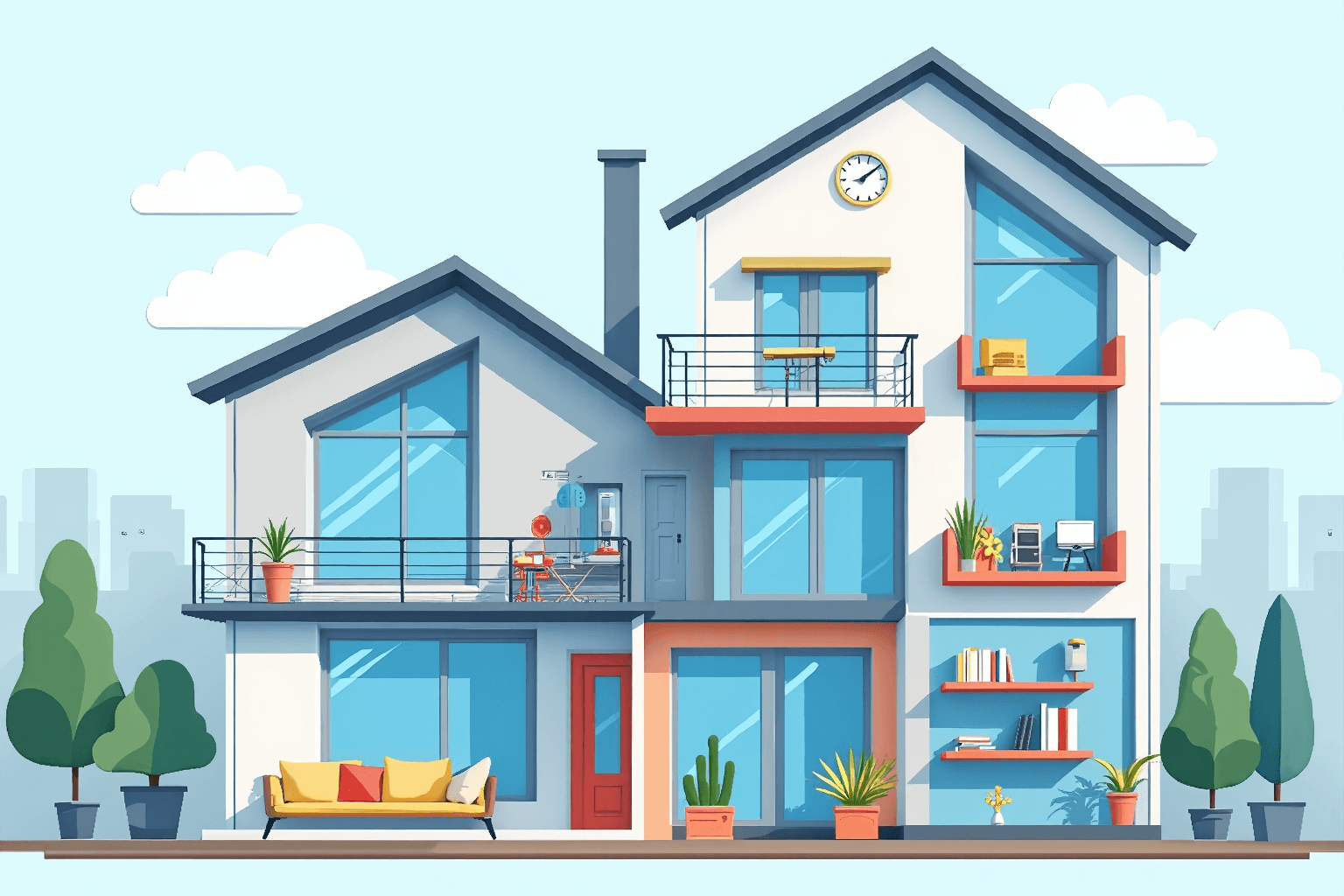Introduction: The Future of Indoor Air Quality
The air we breathe inside our homes is often more polluted than the air outside, a stark reality underscored by the EPA. Breathing easy in your home is no longer a luxury but a fundamental necessity, impacting not just comfort but overall health and well-being. In 2025, premium home air quality management has become paramount, driven by rising awareness of indoor air pollutants and the availability of sophisticated technologies that offer homeowners unprecedented control over their indoor environment.
This comprehensive guide delves into the latest advancements in air purification, humidity control, and environmental monitoring, empowering you to create a healthier, more comfortable, and ultimately, more sustainable living space. The convergence of smart home technology and a growing emphasis on wellness has elevated indoor air quality to a top priority for homeowners. From invisible threats like volatile organic compounds (VOCs) emanating from everyday household products to particulate matter (PM2.5) infiltrating from outdoor sources, the need for advanced air quality solutions is more critical than ever.
Integrating smart air purifiers, intelligent humidity controllers, and real-time environmental monitoring systems is no longer a futuristic concept but a tangible reality, readily accessible to enhance the health and comfort of any home. These interconnected systems, controllable through intuitive smartphone apps and integrated with other smart home devices, offer a proactive approach to maintaining a healthy indoor environment. Imagine a home where the air purifier automatically ramps up when cooking fumes are detected, or the humidity level adjusts dynamically based on real-time weather conditions.
This level of personalized control is now achievable, transforming the way we interact with our living spaces. Moreover, advancements in interior design are increasingly incorporating air quality considerations. Designers are now specifying low-VOC paints, flooring, and furniture, and strategically placing air purification systems to maximize efficiency and minimize visual impact. This holistic approach to indoor air quality seamlessly blends health, technology, and aesthetics, creating homes that are both beautiful and healthy. Investing in these technologies not only improves indoor air quality but also contributes to sustainability efforts by reducing energy consumption through optimized HVAC performance and minimizing the use of chemical air fresheners. By embracing these advancements, we move towards a future where clean, healthy indoor air is a standard, not a privilege.
Advanced Air Purification Systems: A Deep Dive
Advanced air purification systems represent a significant leap beyond basic filtration, offering a multi-layered defense against a wide spectrum of indoor air pollutants. These systems leverage cutting-edge technologies to create a healthier and more comfortable home environment. High-Efficiency Particulate Air (HEPA) filters, a cornerstone of modern air purifiers, are designed to capture microscopic particles, including dust mites, pollen, pet dander, and other allergens, with remarkable efficiency, often exceeding 99.97% for particles as small as 0.3 microns.
This makes them particularly beneficial for allergy sufferers and individuals sensitive to airborne particulate matter. Electrostatic precipitators, another powerful technology, utilize electrical charges to attract and trap airborne pollutants like dust, smoke, and other fine particles. This method is highly effective at removing even ultrafine particles that can bypass traditional filters, contributing to improved respiratory health and overall indoor air quality. Furthermore, integrating these systems with smart home technology allows for automated control and real-time monitoring of air quality data, creating a truly intelligent and responsive indoor environment.
Activated carbon filters play a crucial role in absorbing gases and odors, effectively neutralizing volatile organic compounds (VOCs) emitted from common household products, paints, and furnishings. These filters are essential for mitigating the health risks associated with VOC exposure, which can range from mild irritation to more serious respiratory issues. UV germicidal irradiation provides an additional layer of protection by neutralizing viruses, bacteria, and other harmful microorganisms. This technology utilizes ultraviolet light to disrupt the DNA of these pathogens, rendering them inactive and preventing their spread.
While effective, it’s important to note that UV-C light should be used cautiously and within the manufacturer’s guidelines. The strategic combination of these technologies allows advanced air purification systems to target a comprehensive range of pollutants, from PM2.5 and VOCs to allergens, pathogens, and even unpleasant odors. This multi-pronged approach is key to achieving truly premium indoor air quality. Selecting the right air purification system depends on individual needs and the specific pollutants of concern.
Homeowners should consider factors such as room size, the types of pollutants present, and desired features like smart home integration and energy efficiency. For example, a household with pets might prioritize a system with a robust HEPA filter and odor control, while a home in a high-pollution area might benefit from an electrostatic precipitator. Consulting with an indoor air quality specialist can provide personalized recommendations and ensure the chosen system effectively addresses specific needs and environmental factors.
Regular maintenance, including timely filter replacements as recommended by the manufacturer, is paramount for optimal performance and longevity. Neglecting filter changes can significantly reduce the system’s effectiveness and potentially lead to increased energy consumption. Choosing energy-efficient models and utilizing smart home features, such as scheduling and automation, can help minimize the system’s environmental impact and operating costs. Investing in a high-quality air purification system is a significant step towards creating a healthier, more comfortable, and sustainable home environment, ultimately contributing to improved well-being and peace of mind.
From an interior design perspective, modern air purifiers can be seamlessly integrated into the home aesthetic. Many manufacturers offer sleek and stylish designs that complement contemporary interiors. Some models can even be incorporated into existing HVAC systems for a discreet and space-saving solution. This allows homeowners to prioritize air quality without compromising their design preferences. Moreover, improved air quality can contribute to a healthier indoor environment for houseplants, promoting their growth and vibrancy. This adds another layer of benefit for those who appreciate the aesthetic and air-purifying qualities of indoor greenery. By carefully considering the placement and design of air purifiers, homeowners can enhance both the health and beauty of their living spaces.
Humidity Control: Balancing Comfort and Health
Maintaining optimal humidity levels is crucial for a healthy and comfortable home environment. Too much moisture can lead to mold growth, mildew, and dust mites, triggering allergies and respiratory problems. Conversely, excessively dry air can exacerbate respiratory conditions, dry out skin and mucous membranes, and even damage wooden furniture and musical instruments. Whole-house humidifiers and dehumidifiers offer effective solutions for regulating moisture content and preventing these issues. Smart humidifiers, integrated with smart home systems, allow for automated control based on real-time humidity readings and personalized preferences, optimizing energy efficiency and comfort.
For example, during dry winter months, a smart humidifier can automatically maintain a comfortable humidity level, while in humid summers, a smart dehumidifier can prevent excess moisture and the associated health risks. Choosing the right technology depends on your climate, lifestyle, and the specific needs of your home. Beyond whole-house systems, portable humidifiers and dehumidifiers offer targeted solutions for individual rooms. These are particularly useful for bedrooms, nurseries, or home offices where specific humidity levels are desired.
Smart portable units often include features like air purification and aromatherapy, further enhancing indoor air quality. For instance, a smart humidifier in a baby’s room can help alleviate dry air and congestion, promoting better sleep. When selecting a portable unit, consider factors like room size, noise levels, and ease of maintenance. Regular cleaning is essential to prevent the growth of bacteria and mold within the unit itself. Integrating humidity control with other smart home technologies can further enhance indoor air quality management.
Smart thermostats can be programmed to work in conjunction with humidifiers and dehumidifiers, optimizing both temperature and humidity levels for maximum comfort and energy efficiency. Some advanced systems even incorporate air quality sensors that detect VOCs (Volatile Organic Compounds) and other pollutants, automatically adjusting ventilation and filtration to maintain a healthy indoor environment. Imagine a scenario where your smart home system detects elevated humidity levels after a shower. It could automatically activate the bathroom exhaust fan and, if necessary, trigger the dehumidifier to prevent mold growth.
This level of automation not only improves air quality but also simplifies home management. The aesthetic impact of humidity control should also be considered, particularly in the context of interior design. Proper humidity levels can help preserve the integrity of wooden furniture, flooring, and artwork, preventing warping, cracking, and discoloration. Furthermore, a comfortable humidity level contributes to a more pleasant and inviting living space. Interior designers are increasingly incorporating smart humidity control solutions into their projects, recognizing the importance of indoor air quality for both health and aesthetics.
By seamlessly integrating these technologies into the overall design scheme, they can create beautiful and healthy homes that meet the needs of modern living. Finally, sustainable practices play a significant role in humidity management. Energy-efficient humidifiers and dehumidifiers minimize energy consumption, reducing your environmental footprint. Furthermore, proper humidity control can help reduce the need for excessive heating and cooling, further contributing to energy savings. By choosing sustainable humidity control solutions and integrating them into a holistic smart home ecosystem, homeowners can create a healthier, more comfortable, and environmentally responsible living environment.
Environmental Monitoring: Data-Driven Air Quality Management
Smart sensors are transforming how we monitor indoor air quality, moving beyond simple thermostats to become sophisticated environmental sentinels. Real-time data on particulate matter (PM2.5), carbon dioxide (CO2), volatile organic compounds (VOCs), temperature, and humidity provide valuable insights into your home’s environment, allowing for proactive interventions rather than reactive measures. For instance, elevated PM2.5 levels, often caused by cooking or nearby construction, can trigger alerts, prompting immediate adjustments to ventilation or air purifier settings. Similarly, CO2 monitoring can indicate the need for increased fresh air intake, especially in tightly sealed, energy-efficient homes, contributing to a healthier and more comfortable living space.
These sensors represent a crucial intersection of technology and healthy home design, enabling homeowners to create living spaces optimized for well-being. This data is not only accessible but also actionable, visualized through user-friendly interfaces on smartphones, tablets, and smart home hubs. These interfaces often present data trends, historical readings, and personalized recommendations for improving air quality based on established health guidelines and individual preferences. For example, if VOC levels consistently spike during specific times of the day, the system might suggest identifying and replacing potential sources, such as cleaning products or certain types of furniture.
Furthermore, many systems offer comparative data, allowing homeowners to benchmark their indoor air quality against regional averages or established standards, fostering a deeper understanding of their environmental footprint and potential areas for improvement. The integration of data visualization elevates environmental monitoring from a passive observation to an active management strategy. Integration with smart home automation systems enables automated control of ventilation, air purifier operation, and humidity regulation, creating a truly intelligent and responsive indoor environment.
Imagine a scenario where the air quality sensor detects elevated allergen levels during pollen season. The system could automatically activate the HEPA filter in the air purifier, adjust the HVAC system to increase fresh air intake while minimizing outdoor allergen infiltration, and even send a notification to family members with allergies, recommending they take appropriate precautions. This level of automation not only enhances comfort and convenience but also promotes energy efficiency by optimizing system performance based on real-time needs.
This seamless integration between environmental monitoring and smart home control exemplifies the future of healthy home technology. From an interior design perspective, these sensors are becoming increasingly discreet and aesthetically integrated into the home environment. Early models were often bulky and obtrusive, but newer designs prioritize sleek profiles and seamless integration with existing décor. Some sensors are even disguised as decorative objects or incorporated into smart thermostats and lighting fixtures, minimizing their visual impact while maximizing their functionality.
This design-conscious approach reflects a growing awareness that technology should enhance, not detract from, the overall aesthetic of the home. Furthermore, the data provided by these sensors can inform design choices, such as selecting low-VOC paints and furnishings or optimizing ventilation strategies to promote natural airflow and reduce reliance on mechanical systems. The sustainability implications of advanced environmental monitoring are also significant. By providing detailed insights into energy consumption and air quality patterns, these systems empower homeowners to make more informed decisions about their environmental impact.
For instance, identifying periods of peak energy usage for air purification or humidity control can lead to adjustments in usage patterns or the adoption of more energy-efficient technologies. Moreover, real-time monitoring can help prevent unnecessary energy waste by ensuring that systems are only operating when needed. By promoting responsible resource management and fostering a greater awareness of indoor environmental quality, these technologies contribute to a more sustainable and healthy home for both occupants and the planet.
Conclusion: Breathe Easy in the Future
Investing in premium home air quality management is an investment in your health and well-being, a proactive step that yields dividends in comfort, productivity, and long-term wellness. As technology continues to evolve, we can expect even more sophisticated solutions, such as AI-powered air purifiers that learn your habits and anticipate air quality fluctuations, and personalized ventilation systems that dynamically adjust airflow based on occupancy and activity. By staying informed about the latest advancements and adopting proactive measures, you can create a home environment that promotes optimal health and comfort for years to come.
This commitment extends beyond mere convenience; it’s about fostering a sustainable and healthy living space. The convergence of smart home technology and air quality management is creating unprecedented opportunities for homeowners. Imagine a system that not only monitors PM2.5 levels but also automatically adjusts your HVAC system, triggers an air purifier equipped with a HEPA filter, and sends you a notification if VOCs from new furniture exceed acceptable thresholds. Such integrated systems are becoming increasingly accessible, offering a holistic approach to indoor air quality.
These advancements also align with sustainability goals by optimizing energy consumption based on real-time environmental conditions, reducing your carbon footprint while enhancing air quality. Interior design is also playing a crucial role in promoting healthy indoor air. Choosing low-VOC paints, sustainable flooring options like bamboo or cork, and natural fiber rugs can significantly reduce the introduction of harmful chemicals into your home. Furthermore, incorporating indoor plants not only enhances the aesthetic appeal of your living space but also contributes to improved air quality by absorbing pollutants and releasing oxygen.
Consider strategically placing plants known for their air-purifying properties, such as snake plants, spider plants, or peace lilies, to create a healthier and more vibrant indoor environment. Home improvement projects should increasingly prioritize air quality considerations. When renovating, ensure proper ventilation during and after construction to mitigate the release of dust, fumes, and other airborne irritants. Consider installing energy-efficient windows and doors to minimize drafts and improve insulation, which can help regulate temperature and humidity levels, further contributing to better indoor air quality.
Integrating smart home technology during renovations, such as installing smart thermostats and humidity sensors, allows for continuous monitoring and automated adjustments, ensuring a consistently healthy and comfortable living environment. Ultimately, the future of home air quality management lies in personalized, data-driven solutions. Environmental monitoring systems will become even more sophisticated, providing detailed insights into the specific pollutants affecting your home. This data will empower you to make informed decisions about air purification strategies, humidity control measures, and lifestyle choices that impact your indoor air quality. Embracing these technological advancements and adopting a proactive approach to air quality management will transform your home into a sanctuary of health and well-being, ensuring a brighter and healthier future for you and your family.



